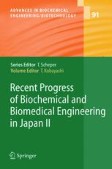Search
Search Results
-
Bacterial Sterilization and Intracellular Protein Release by a Pulsed Electric Field
Several biotechnological applications of high-voltage pulsed electric field (PEF) are introduced. Electrical breakdown or disruption of a biological...
-
Facts and Theories of Induced Organ Regeneration
Induced organ regeneration is de novo synthesis of a physiological, or nearly physiological, organ at the same anatomical site as the organ that is...
-

-
Heart Valve Regeneration
The valves of the heart cannot regenerate spontaneously. Therefore, heart valve disease generally necessitates surgical repair or replacement of the...
-
Lager brewing yeast
Lager brewing yeast is a group of closely related strains of Saccharomyces pastorianus/S. carlsbergensis used for lager beer production all over the...
-
Fatty Acids from Lipids of Marine Organisms: Molecular Biodiversity, Roles as Biomarkers, Biologically Active Compounds, and Economical Aspects
Because of their characteristic living environments, marine organisms produce a variety of lipids. Fatty acids constitute the essential part of...
-
Marine Microalgae
Marine microalgae, the largest primary biomass, have been attracting attention as resources for new metabolites and biotechnologically useful...
-
Inclusion Bodies: Formation and Utilisation
The efficient in vivo folding of many heterologous proteins is a major bottleneck of high level production in bacterial hosts and simple optimisation...
-
Monitoring of Stress Responses
New developments in the RNA analysis techniques now enable a comprehensive view on the bacterial physiology under bioprocess conditions. The DNA-chip...
-
Functional Magnetic Particles for Medical Application
Magnetic particles for medical applications have been developed by many researchers. Since magnetic particles have unique magnetic features not...
-
Analysis and Control of Proteolysis of Recombinant Proteins in Escherichia coli
Proteolysis is one of the reasons for poor production of recombinant proteins in Escherichia coli. Important properties of E. coli proteases, which...
-
Novel Genes Involved in Cephalosporin Biosynthesis: The Three-component Isopenicillin N Epimerase System
Cephalosporin is one of the best β-lactam antibiotics, widely used in the treatment of infectious diseases. It is synthesized by Acremonium...
-
Simultaneous In Vivo Regeneration of Neodermis, Epidermis, and Basement Membrane
Full-thickness skin loss does not undergo complete spontaneous regeneration in mammals. To restore the normal function of skin, dermal and epidermal...
-
Marine Pharmacology: Potentialities in the Treatment of Infectious Diseases, Osteoporosis and Alzheimer's Disease
Several molecules isolated from various marine organisms (microorganisms, algae, fungi, invertebrates, and vertebrates) are currently under study...
-
Bioprocess Engineering Data on the Cultivation of Marine Prokaryotes and Fungi
The temperature/pressure dependency of marine prokaryotes and fungi, in terms of their growth behaviour as well as their potential to produce new...
-
The Application of Multi-Parameter Flow Cytometry to Monitor Individual Microbial Cell Physiological State
The development of multi-parameter flow cytometric techniques in our laboratories has led to a functional classification of the physiological state...
-
Development of Culture Techniques of Keratinocytes for Skin Graft Production
The in vitro cultures of human tissues have attracted a great deal of medical attention as a promising technique for repairing defective tissues in...
-
Large-Scale Micropropagation System of Plant Cells
Plant micropropagation is an efficient method of propagating disease-free, genetically uniform and massive amounts of plants in vitro. The scale-up...
-
Regulation of Cephalosporin Biosynthesis
The filamentous fungus Acremonium chrysogenum is the natural producer of the β-lactam antibiotic cephalosporin C and is as such used worldwide in...
-
Control of Fluxes Towards Antibiotics and the Role of Primary Metabolism in Production of Antibiotics
Yield improvements in antibiotic-producing strains have classically been obtained through random mutagenesis and screening. An attractive alternative...
